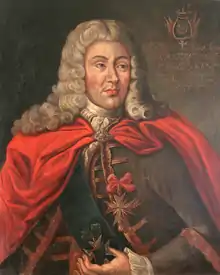Jerzy Siemiginowski-Eleuter
Jerzy Siemiginowski-Eleuter (born Jerzy Szymonowicz; c. 1660 – c. 1711) was a prominent Polish painter and engraver of the Baroque style. He was court painter of king John III Sobieski[1] and a Polish–Lithuanian noble. He is considered one of the most accomplished painters of Classical Baroque in Poland, who joined in his works classical theory with genuine motives.[2]
Jerzy Siemiginowski-Eleuter | |
|---|---|
 | |
| Born | Jerzy Szymonowicz c. 1660 |
| Died | c. 1711 Lwów, Polish–Lithuanian Commonwealth |
| Nationality | Polish |
| Known for | Painting, Engraving |
| Movement | Baroque |
| Patron(s) | John III Sobieski |
Life and professional career
Siemiginowski was of Armenian origin.[3][4] He was born in Lwów (Lviv) in the Polish–Lithuanian Commonwealth (today part of Ukraine) and was the son of a painter Jerzy Szymonowicz and Teodozja née Korunka. In 1677 he was entrusted to the king John III Sobieski by his parents and was sent by the king to Rome.[2] Before he went to Rome he probably spent at least a year, possibly two, in Paris. In 1682 due to recommendation of king John III he was admitted to Accademia di San Luca in Rome, he receive the Knighthood of the Golden Spur and the title of Eques Auratus from the Pope Innocent XI. On 11 January 1682 he also took first place award in the Academy's contest for two of his drawings Construction of the Tower of Babel, and God's anger caused by the building of a tower and was protected by the Pope's nephew Livio Odescalchi.[2] In Rome he was trained by Lazzaro Baldi, Luigi Garzi[2] and Carlo Maratta.[5]


Shortly after his return to Poland in 1684 he was ennobled by the king and took the name of Chevalier Eleuter (Greek for free, independent). In 1687 John III granted him the village Łuka near Złoczów (Zolochiv) to confirm his nobility.[2] After king's death he became secretary of Augustus II the Strong and was a court painter of Aleksander Benedykt Sobieski.[2] At that time he still worked in Wilanów (Sobieski's suburban palace) and supervised the construction of new palace's wings. In 1701 he was adopted by the impoverished noble family of Siemiginowski (he paid them lot of money for this privilege) and since that time he used their name.[2] Siemiginowski was married four times and had 11 children. In 1704 he had a house in Warsaw and a manor house at Wielopole near Warsaw. He died probably between February 28, 1708 and March 13, 1711.[2]
Siemiginowski-Eleuter was the main artist who was responsible for decorating and painting of the interior of Wilanów Palace in Warsaw.[1] His painting was heavily influenced by French artists of the Baroque. Similarities with plafonds by Charles Le Brun in his works (especially ceiling painting in Pavillon de l'Aurore in suburban Paris residence of Jean-Baptiste Colbert at Sceaux, 1671 or 1672) making his visit in Paris more probable. Influences of Carlo Maratta and Nicolas Poussin are also visible in his works (especially in his plafond Allegory of Spring in the Queen's Bedroom inspired by Maratta's Flora and Changes in the Kingdom of Flora by Poussin).[6] He painted antiquitised portraits of the members of the royal family and made engravings in participation of Charles de La Haye.[2] Siemiginowski painted many frescoes, notable for their many colors. His subject matter varied between dramatic scenes to peaceful landscapes. Among the most notable of his works are four plafonds of the four seasons in the Wilanów Palace.[7] Siemiginowski established his own school of painting in Wilanów and was a renowned architect (participated in designing of the Town Hall in Żółkiew (Zhovkva)).[2] Many of his religious paintings in Warsaw (Crucifixion in the Holy Cross Church, Transfiguration in the Capuchin Church among others) were destroyed during the extensive bombardment of the city by the Germans in 1944.[2]
References
- "Siemiginowski, a painter of Jan III Sobieski". wilanow-palac.art.pl. Retrieved 2011-11-02.
- Renata Sulewska (2002). "Jerzy Eleuter Siemiginowski (Szymonowicz)". www.culture.pl. Retrieved 2010-01-19.
- Deluga, Waldemar (2011). "Armenian Art in Warsaw (18th and 19th Centuries)". Annales Universitas Apulensis. Series Historica. Universitatea. 15 (2): 50. ISSN 1453-9314.
- Szulakowska, Urszula (2018). Renaissance and Baroque Art and Culture in the Eastern Polish-Lithuanian Commonwealth (1506-1696). Cambridge Scholars Publishing. p. 90. ISBN 978-1527511354.
- Fijałkowski 1983, p. 22
- Fijałkowski 1983, p. 67
- Michael J. Mikoś. "Baroque". www.staropolska.pl. Retrieved 2009-05-13.
Bibliography
- Fijałkowski, Wojciech (1983), Wilanów. Rezydencja Króla Zwycięzcy (Wilanów. The residence of the Victorious King) (in Polish), Warsaw: Krajowa Agencja Wydawnicza.
Works in Wilanów Palace
Ceiling paintings
| Wikimedia Commons has media related to Jerzy Siemiginowski-Eleuter. |
 Allegory of Winter, 1683
Allegory of Winter, 1683 Allegory of Spring, 1680s
Allegory of Spring, 1680s Allegory of Summer, 1684−1686
Allegory of Summer, 1684−1686
Portraits
 Queen Marie Casimire with children, 1684
Queen Marie Casimire with children, 1684 John III Sobieski at the Battle of Vienna, 1686
John III Sobieski at the Battle of Vienna, 1686 Konstanty Władysław Sobieski, c. 1690
Konstanty Władysław Sobieski, c. 1690
External links
- (in Polish) Biography
![]() Media related to Jerzy Siemiginowski-Eleuter at Wikimedia Commons
Media related to Jerzy Siemiginowski-Eleuter at Wikimedia Commons